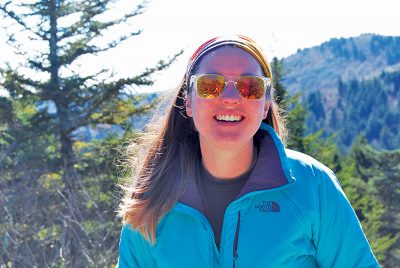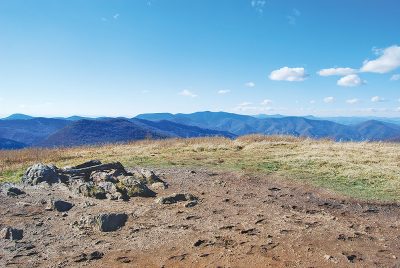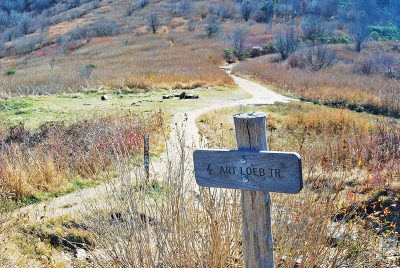By Melanie Harsha
On the night before Halloween 2017, just after Western North Carolina’s first wintry storm of the season, I embarked on a short overnight backpacking trip.
The Art Loeb Trail is a point-to-point backpacking trail that is just over 30 miles long, located near Canton, N.C. It is named for Art Loeb, a resident of Brevard, N.C., who had a passion for hiking and was a member of the Carolina Mountain Club.
Black Balsam Knob to Shining Rock is perhaps the most scenic section along the trail. This 8.3-mile portion of the trail offers 360-degree views, green rhododendron tunnels and several spur trails to explore other areas.
My hiking partner and I chose to do this particular section as an overnight, but this could easily be accomplished on a day hike, or could be extended to a multi-night backpacking trip.
Black Balsam Knob is just off the Blue Ridge Parkway and a short walk from a parking area, making it extremely popular throughout the year. A few miles away from the knob, however, the trail becomes more remote, especially in the colder months.
We hiked just after a cold snap, when the trail had quite a bit of ice and snow. This also meant the night was rather brisk — around freezing temperatures — and I made sure to bring my cold weather supplies.
During my research prior to this trip, I read that the trail was unclearly marked, overgrown and hard to follow at some points. I had quite the opposite experience, though this may be because I hiked during a time of year when the vegetation was less dense. The Art Loeb Trail was well-marked with white blazes and numerous wooden signs. I also used GPS mapping on my phone and had a paper map and a compass as backup.
Water is sparse on this trail for most of the year, though it was plentiful during my hike because the snowmelt supplied springs along the way. Just before Shining Rock, a piped spring provides a reliable water source throughout the year. It is safe to say that if the area recently received precipitation, there will be water available. However, make sure to pack in plenty of water just in case, and bring the necessary accoutrements for water treatment.
The Hike
A wide, graveled path leads into a wooded area for a couple hundred yards until you reach a clearing with your first view of Black Balsam Knob. The trail goes to the top of the grassy bald with roughly 300 feet of elevation gain. There are several great spots to stop for a picture or snack on top of the bald. Over the next two miles, the trail crosses balds with panoramic views of Pisgah National Forest and glimpses of the Blue Ridge Parkway.
After these two miles of sweeping vistas, the trail dips into a wooded area for about half of a mile, where you will find a perfect site to set up camp away from the elements. This section of trail is a bit rocky and muddy, but soon changes back to more forgiving terrain.
Coming out of the woods, the trail travels around another bald leading to a campfire ring and several campsites. This, in my opinion, is the most scenic campsite on this section of trail. In fact, the balds offer some of the most beautiful campsites in the Blue Ridge Mountains. There are plenty of campsites along this trail, so there is no need to disturb the vegetation in order to create a new site. In harsh weather, however, it’s best to avoid camping on the balds to minimize exposure to high winds.
Just after this campsite, you will see a horse trail and another hiking spur trail to your left, with a large sign that reads “Shining Rock Wilderness” and a detailed map with important trail updates. If you take a spur trail, be sure to get back on the Art Loeb, as it can be confused with the other spur trails.
The next mile goes around a relatively flat bald, a section that can become muddy and slippery during wet weather. This last mile before Shining Rock has a mixture of panoramic views and dips into green tunnels of mountain laurel and rhododendron, which bloom in late spring.
Just 50 yards beyond a piped spring on your right, a sign reads “Shining Creek/Big East Fork Trailhead – 3.4 miles.” Go about 100 yards past this sign and you will come to a circular clearing surrounded by wooded campsites that are sprinkled within the forest.
To your left, there is a 4.4-mile spur trail to Deep Gap and Cold Mountain, but if you continue straight the trail will take you to the top of the iconic Shining Rock.
Art Loeb Trail: Black Balsam Knob to Shining Rock
- Length: 8.3 miles, out and back
- Difficulty: Moderate
- Directions: At mile marker 420 on the Blue Ridge Parkway, turn onto Forest Service Road 816 (Black Balsam Knob Road). The trailhead is just under a mile on your right. Campfires are prohibited. Bear canisters for food are required. Dogs are allowed.
- Contact: Pisgah National Forest, (828) 877-3265
The 0.3-mile climb to the summit of Shining Rock is technical but well worth it. I highly suggest catching the sunset at the top of the massive, white granite boulder. Be sure to bring a headlamp if you plan on climbing down in the dark.
I chose to set up my tent for the evening on the soft pine needles at one of the tree-covered campsites at the base of Shining Rock. This night we had the site to ourselves, which allowed us to hear the owls hooting nearby and the coyotes howling in the distance.
The next morning we awoke to a light frost and, after a healthy breakfast of Snickers bars, we packed up camp. There wasn’t a cloud in the sky, which made for a beautiful view for our second time atop Shining Rock. After climbing down, we started on the 4.15-mile return trek towards the car. Traversing over Black Balsam Knob and admiring the fall colors convinced me to return to Art Loeb, but next time to hike it in its entirety.
Editor’s note: This article was updated on Dec. 18 to reflect the fact that campfires are prohibited in Shining Rock and Middle Prong Wilderness Areas.
Related Articles
Latest News

Leave a comment
Your email address will not be published. Required fields are marked *








